PDF of this article (283 KB)
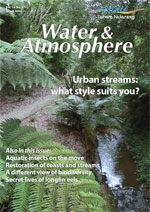

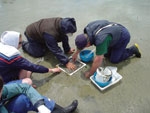
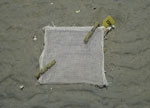
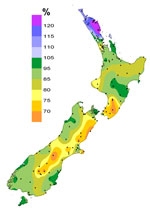
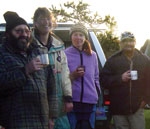
Many hands lighten the load when it comes to counting, measuring, and recording the cockles that have survived in the white mesh cages. The fellowship of hard work is sealed at the end of the day with a welcome cuppa. (Photos: Vonda Cummings, Luca Chiaroni, and Donnelle Fletcher)

The wide sandflats of Whangarei Harbour at low tide, and the white cages containing transplanted cockles. (Photo: Jane Halliday)
Vonda Cummings describes a collaborative community project that aims to 'bring the harbour alive'.
In the last decade, community groups have become increasingly concerned about declining shellfish stocks in estuarine and coastal areas around New Zealand. There is growing interest in reversing these effects through restoration of degraded shellfish beds. Because there’s no one 'recipe' for how to go about this restoration, there’s a pressing need for fundamental research in this area.
Figuring out the basics
Growth and survival of shellfish are affected by a number of factors, from the physical environment (such as waves and substrate), to water quality, pollution, and the biological environment (including predation, competition, and food). A number of decisions need to be made on the actual processes employed for restoration. For example, what’s the most suitable habitat? At what level on the shore is best? What size and densities of shellfish should be transplanted? What time of year?
These decisions are complicated by the fact that different life-history stages of the same species will have different requirements for optimum growth and survival. For many species, knowledge of their particular requirements is limited. Shellfish restoration has previously met with mixed success overseas, and has not yet been attempted on a large scale in New Zealand.
Trial projects in Whangarei
For the past couple of years, members of the Whangarei Harbour Kaitiaki Roopu (caretaker group) have been working with scientists from NIWA, planning and implementing shellfish re-seeding trials in the harbour. The ultimate aim of the project is to give shellfish populations a helping hand in areas of Whangarei Harbour where they were once more plentiful than today and, in doing so, to 'bring the harbour alive'. We want to combine traditional and scientific knowledge, and to educate people about shellfish issues. Eventually, we hope to pass on the knowledge gained from this work to people from other groups and harbours who are interested in shellfish restoration.
Initially, we checked out different areas of the harbour to determine whether it would be possible to help restore shellfish populations. This enabled us to identify sites and species that might be suitable for future re-seeding. We consequently decided to establish some tuangi (cockle) restoration trials on a large sandflat on the southern side of the harbour, at Takahiwai.
In July 2004, we transplanted cockles to two different areas on the Takahiwai sandflat. Half of the cockles were placed in cages, to protect them from potential predators, and we transplanted cockles at different densities. We have monitored the cockles at regular intervals since, recording how many have survived and how large they grew, to help us assess the success of the re-seeding trials in the long term. After one year, results showed higher survival in uncaged plots. In November 2005, we began new trials using a variety of plot sizes and constant cockle densities. As before, we will monitor their growth and survival at regular intervals to determine their success; we envisage that these trials will remain in place for at least a year.
Ensuring local commitment
This work was initiated, and has been driven, by the Whangarei Harbour Kaitiaki Roopu. All stages of the planning and implementation of this project have involved NIWA scientists working closely with a working group derived from the kaitiaki rōpū.
We began by establishing common goals and expectations for the shellfish re-seeding operations. Restoration requires a great deal of effort over a long period (more than five years), so it’s crucial that the people involved understand what’s required and why, and have been involved in making key project decisions. There is now a group of local people, many from the local marae, who are committed long term to being involved in the shellfish re-seeding, and who have realistic expectations of its outcome. We anticipate that within the next few years this group will eventually take on full ownership of the re-seeding project, with guidance from NIWA scientists when needed. Ownership of the project by the local people is crucial for the overall success of these types of projects.
Bringing back the shellfish
- Loss of kai moana from our coasts and estuaries is a growing concern.
- Community groups are keen to restore these areas.
- A project under way to restore cockle beds in Whangarei Harbour combines the efforts of NIWA scientists, local hapū, and the harbour's kaitiaki rōpū.
Tēnei te mihi maioha o NIWA ki a koutou o Takahiwai. Nā koutou i tautoko tō mātou nei rangahau ki a whakaorangia ngā wāhi mahinga kai o te tuangi i roto i ngā wahapū o Whangarei. Mauri Ora.
NIWA would like to take this opportunity to thank those families from Takahiwai for supporting and assisting with this research project to restore the cockle to the shellfish beds in and around the Whangarei Harbour.
'Ka pūwaha te tai nei hoea tātou.' 'When there is a break in the waves, we will paddle together.'
The view from here
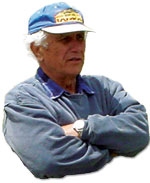
Local iwi and hapū are keen to see the rapid decline in shellfish and fish numbers over recent years reversed. The banks within the Whangarei Harbour west of One Tree Point, and in particular the Takahiwai flats, were areas of major sources of shellfish, and in particular cockles, until about the 1960s. After that time it became increasingly difficult to find acceptable size shellfish in any great number. Before this it was an easy choice as to where to go for the next bucket or sack of cockles. Older people will remember the ease with which we caught fish and the great abundance of a variety of kai moana, which is not the case today.
We, the local hapu, enjoy working with the NIWA scientists and the Whangarei Harbour Kaitiaki Roopu in doing our bit to ensure success in bringing the health of the Whangarei Harbour back to what we older residents remember, for the enjoyment of future generations.
Grant Pirihi, long-time Takahiwai resident
Dr Vonda Cummings is a benthic ecologist based at NIWA in Wellington. This project is funded by Northport Ltd as part of the Northland Regional Council’s Whangarei Harbour Health Improvement Fund, and the Foundation for Research, Science & Technology’s ‘Restoration of Aquatic Ecosystems’ programme.
Teachers’ resource for NCEA AS: Biology 90164 (1.4), 90460 (2.4), 90461 (2.5). See other curriculum connections at www.niwa.co.nz/pubs/wa/resources
